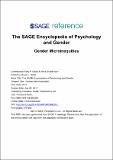3. Micro-inequities, Micro-agressions, and Micro-affirmations
Micro-inequities: The term “micro-inequities” is an extension of Professor Chester Pierce’s original 1970 work on racist micro-aggressions—everyday, subtle, intentional or unintentional interactions or behaviors that are perceived to communicate bias and/or hostility. In 1973, Mary Rowe’s original definition of micro-inequities was: “apparently small events which are often ephemeral and hard-to-prove, events which are covert, often unintentional, frequently unrecognized by the perpetrator, which occur wherever people are perceived to be ‘different.’” Her definition was later expanded to include a yet-wider set of all micro-events whose effects are perceived to be unfair, whether or not “aggressive.”
Micro-affirmations: Rowe defined this term in 1973 as“apparently small acts, which are often ephemeral and hard-to-see, events that are public and private, often unconscious but very effective, which occur wherever people wish to help others to succeed.”
Recent Submissions
-
Micro-Affirmations Are Joining the Social Science Research Agenda
(MIT Sloan School of Management website, 2024-12) -
BELONGING—The Feeling That We ‘Belong’ May Depend in Part on ‘Affirmations'
(Journal of the International Ombudsman Association, 2023)This essay describes a poignant concern brought to the ombuds office that helped me to understand how micro-affirmations are a major part of the scaffolding of “belonging.” -
Gender Microinequities
(SAGE Publications, 2017-07)Despite laws, regulations, and policies promoting gender equity, and some progress in education and employment settings, gender discrimination continues. Much gender bias is subtle, covert, and usually not legally actionable, ...


